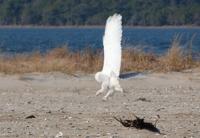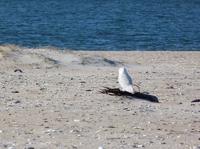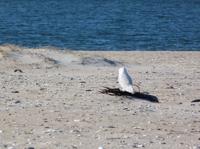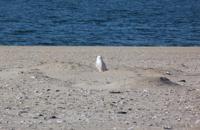A rare bird sighting on the Eastern Shore of Virginia.
A Snowy Owl, the largest North American owl, paid a surprise visit to Virginia’s Eastern Shore last month, spending a few days at Chincoteague National Wildlife Refuge.
According to Matthew Young, biological science technician for Chincoteague National Wildlife Refuge, the reason for the visit is unknown, however, it was not unwelcome.
“It’s truly an awe inspiring moment — when someone sees something that spectacular and striking, it’s a good opportunity for that person to get into nature,” Young says.
The owls are known for their pale shape with catlike yellow eyes and down feathers. According to Young, Snowy Owls are one of the few birds with feathered legs and feet. Snowy Owls are known to be solo travelers — leaving their nests, ultimately venturing by themselves.
Snowy Owls spend summers far north of the Arctic Circle. They show up irregularly in winter to hunt lemmings, ptarmigan and other prey in 24-hour daylight in windswept fields or dunes.
According to Young, Snowy Owls are typically accustomed to temperatures in the 30’s and 40’s during the day and negative values at night, which is one of the reasons why the breed rarely comes as far south as the Eastern Shore.

Snowy Owl perched on a piece of wood (Photo: Chincoteague National Wildlife Refuge)
“No one is one hundred percentage sure why these owls would come this far south but there are speculations,” Young says.
According to Young those speculations include an abundance of prey or a lack thereof. When there’s a year of really good prey, the Snowy Owls are known to produce more young than normal, meaning the more owls there are, more owls will travel south, Young says.
The alternate theory is there are fewer prey, forcing the Snowy Owls to venture outside their typical region in search of more.
“It’s hard to know why because it’s really difficult to estimate their population and history since they live so far north in remote areas. The ones they’ve tagged with GPS markers haven’t really come back to same spots.”
According to Young, there was just one Snowy Owl spotted at the refuge this past December. The said owl was first spotted on Thursday, Dec. 22 by volunteers doing surveys and was seen multiple times leading up to its last appearance on Monday, Dec. 30.

Snowy Owl on the beach at the Chincoteague National Wildlife Refuge (Photo: Chincoteague National Wildlife Refuge)
Although Young was unable to see the Snowy Owl for himself this time around, he’s seen three in his lifetime during the winter of 2014 – 2015.
Young refers to the winter of 2014 – 2015 as an irruptive year, meaning there was an unprecedented amount of birds you typically wouldn’t see at one particular time. According to Young, the Snowy Owls spotted during this time were juveniles, which was identifiable because of the color of the owl’s feathers.
In addition to the winter of 2014 – 2015 and the latest sighting of Snowy Owls, the birds made appearances on Chincoteague in the early 1990’s.
Tips for viewing the Snowy Owl Via Chincoteague National Wildlife Refuge:




























